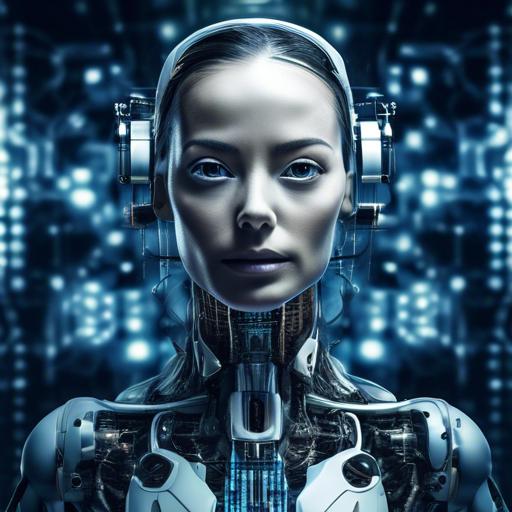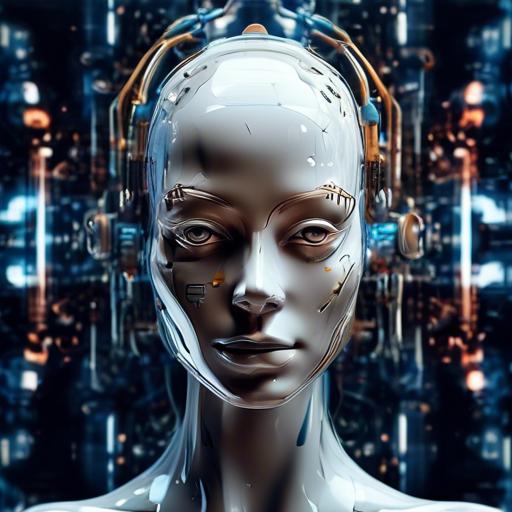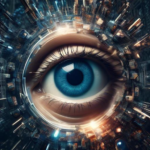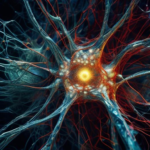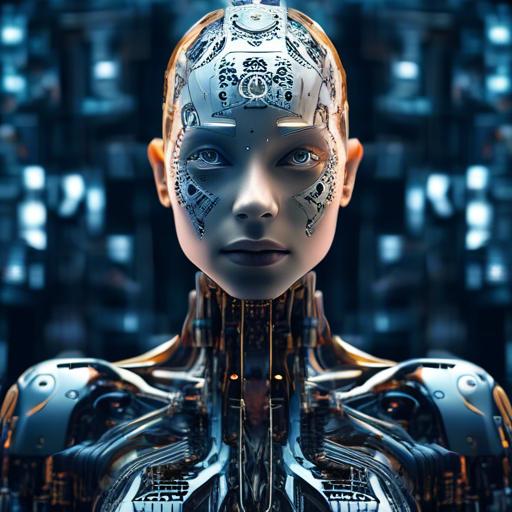Picture this: you’re an artist, and your canvas is the boundless world of imagination. With a mere click, vibrant scenes and fantastical creatures spring to life, infused with nuances beyond your wildest dreams. This isn’t a scenario from a futuristic movie – welcome to the extraordinary realm of AI-powered image generation. In an age where technology continually redefines the limits of creativity, AI stands at the forefront, transforming the way we conceive and create imagery. This burgeoning field, fueled by algorithms and neural networks, bridges the gap between human ingenuity and machine precision. Whether you’re a seasoned artist seeking novel tools or a curious novice yearning to explore uncharted territories, our adventure into AI’s artistic capabilities promises to be enlightening, empowering, and marvelously inventive. So, fasten your seatbelt and ready your imagination – the future of art is here, and it’s powered by artificial intelligence.
Table of Contents
- Understanding the Magic: How AI Translates Data into Imagery
- Essential Components of AI-Powered Image Generation
- Harnessing Neural Networks: The Heart of Image Synthesis
- Real-World Applications: Transforming Industries with AI Artistry
- Ethical Considerations: Navigating the Moral Landscape of AI Art
- Optimizing Quality: Tips for Stunning AI-Generated Visuals
- Choosing the Right Tools: Software Recommendations for Aspiring Creators
- Future Trends: How AI Image Generation is Shaping Tomorrows Visuals
- Final Thoughts
Understanding the Magic: How AI Translates Data into Imagery
Imagine giving an artist a blank canvas and a set of intricate instructions, expecting a masterpiece to emerge. AI operates similarly, except its canvas is a realm of data, and its paintbrushes are powerful algorithms. The essence of how artificial intelligence converts raw data into mesmerizing images lies in its ability to recognize patterns, predict outcomes, and simulate creativity akin to human intuition.
At the heart of this process are neural networks, particularly Generative Adversarial Networks (GANs). These intriguing systems consist of two neural networks: a generator and a discriminator. The generator crafts images from noise, while the discriminator evaluates their authenticity against real-world data. This ongoing tussle sharpens their accuracy, eventually leading to highly convincing images that can mimic anything from human faces to dreamlike landscapes.
Here’s how it works:
- Data Collection: Feeds the AI with a diverse and vast dataset.
- Pattern Recognition: Identifies and learns intricate details and relationships within the data.
- Image Synthesis: Utilizes learned patterns to generate images through the generator-discriminator interplay.
Another fascinating method involves Style Transfer, where AI blends elements from one image to another, akin to mashing up the color scheme of Van Gogh with the composition of a contemporary photograph. The AI uses a dual approach:
- It captures the stylistic features from the source image.
- It overlays these features onto the structure of the target image, resulting in a unique hybrid image.
| AI Technique | Application |
|---|---|
| Neural Networks | Basic image creation and enhancement. |
| GANs | Creating realistic or artistic images. |
| Style Transfer | Combining artistic styles with content imagery. |
Apart from creating visually appealing imagery, these techniques have profound implications in fields like medical imaging, geological analysis, and creative arts. With each iteration, AI learns to emulate human creativity more closely, producing images that are not only functional but also deeply inspiring.
Essential Components of AI-Powered Image Generation
To understand how AI crafts mesmerizing images, it’s crucial to dive into its core elements. At the heart of AI-driven image generation are several key components, each playing a vital role in transforming simple inputs into intricate visuals.
First on the roster is **neural networks**, specifically Convolutional Neural Networks (CNNs). These mimic the human brain’s neural pathways to process visual data, identifying patterns and features. The layers in CNNs filter the input image, progressively refining and understanding edges, textures, and shapes.
Another pivotal piece is the **Generative Adversarial Networks (GANs)**. GANs consist of two neural networks: the generator and the discriminator. The former creates images, while the latter evaluates them for authenticity. Their interplay ensures continuous improvement, leading to surprisingly realistic images. This dynamic tension between generating and critiquing helps AI produce stunning visual art.
A close sibling to GANs is the **Variational Autoencoders (VAEs)**. VAEs work by compressing images into latent space and then reconstructing them. This compression allows these networks to generate new, unique images by manipulating the compressed data. Their ability to produce diverse yet coherent images is indispensable, especially for creative applications.
| Component | Function |
|---|---|
| CNNs | Pattern and feature recognition |
| GANs | Generate and critique images |
| VAEs | Compress and reconstruct images |
Lastly, **pre-trained models** like DALL-E and CLIP by OpenAI offer a head start. These models come pre-equipped with a vast knowledge base, enabling them to generate images from textual descriptions effectively. The blend of language understanding and image generation in these models showcases the power of interdisciplinary AI applications.
Together, these components form a symphony of technology and innovation, each contributing its unique capabilities to produce breathtaking visuals. Whether for art, marketing, or entertainment, the confluence of these elements heralds a new era in digital creativity.
Harnessing Neural Networks: The Heart of Image Synthesis
At the core of today’s most advanced image generation techniques lies the power of neural networks. These sophisticated algorithms enable machines to “see” and recreate images with an unprecedented level of detail and realism. This is particularly evident in the domain of **generative adversarial networks (GANs)**, a class of machine learning frameworks designed to pit two neural networks against each other in a creative duel.
GANs consist of two parts:
- The Generator: This network creates images, starting from a random noise and gradually refining its outputs based on feedback.
- The Discriminator: This network evaluates the generated images, distinguishing between real and synthetic ones.
The constant back-and-forth between generator and discriminator drives both to improve, resulting in astonishingly authentic images.
To enhance the process further, many advanced models employ techniques like **style transfer** and **semantic segmentation**. These methods help neural networks understand different aspects of an image, such as textures and shapes, allowing for even more nuanced and diverse image synthesis.
The ability of these networks to innovate is remarkable. Below is a simple comparison of traditional image processing techniques and those powered by neural networks:
| Feature | Traditional Techniques | Neural Networks |
|---|---|---|
| Detail | Limited | High |
| Realism | Basic | Photorealistic |
| Flexibility | Fixed Rules | Learning & Adaptive |
Developers are continually pushing the boundaries with these tools, exploring exciting frontiers like **deepfake technology** and **super-resolution imaging**. These advancements are making neural networks the beating heart of modern image synthesis, empowering creators to turn abstract concepts into vivid visuals effortlessly.
Real-World Applications: Transforming Industries with AI Artistry
AI-powered image generation is revolutionizing numerous industries by infusing creativity with cutting-edge technology. **Advertising agencies** leverage AI to create visually stunning and personalized marketing campaigns, capturing the audience’s attention more effectively than traditional methods. By automatically generating images that align with consumer preferences and trends, brands can ensure their advertisements are both relevant and engaging.
In the **fashion industry**, AI artistry has found its way into designing clothing and accessories. AI can analyze vast amounts of data on current fashion trends, consumer feedback, and historical styles to generate innovative designs. This not only accelerates the design process but also enables designers to experiment with new ideas and patterns, ultimately pushing the boundaries of fashion.
**Entertainment and media** sectors are equally benefitted. Film and game developers are increasingly leaning on AI to create realistic characters, stunning visual effects, and immersive environments. By using AI, creators can focus more on storytelling and conceptual design while the technical details are managed by advanced algorithms. This collaboration results in richer, more engaging content for audiences.
| Industry | Application | Benefit |
|---|---|---|
| Advertising | Personalized Campaigns | Higher Engagement |
| Fashion | Design Innovation | Faster Process |
| Entertainment | Visual Effects | Enhanced Creativity |
When it comes to **education**, educators are using AI-generated visuals and interactive simulations to create an engaging learning experience. These tools can demonstrate complex concepts in a more understandable and visually appealing manner, catering to various learning styles and improving student comprehension.
The field of **architecture** is also being transformed. AI can quickly generate multiple design iterations, taking into account structural integrity, aesthetics, and environmental sustainability. This allows architects to explore a plethora of design possibilities, ultimately leading to more innovative and sustainable structures.
Ethical Considerations: Navigating the Moral Landscape of AI Art
As we explore the fascinating domain of AI-powered image generation, it’s imperative to address **ethical considerations** associated with this evolving technology. These concerns touch every aspect of AI art, from creation and ownership to societal impact.
- Intellectual Property: One of the core ethical issues is the question of authorship and ownership. When AI algorithms create art, who has the rights to the final product? Is it the developer of the AI, the user who prompted the creation, or the AI itself?
- Plagiarism and Originality: AI algorithms often use vast datasets of existing artworks to learn styles and techniques. This raises concerns about whether the generated images are truly original or just derivative works. How do we ensure that AI art does not unintentionally replicate or infringe upon existing works?
Furthermore, the potential for **bias and representation** must be considered. If the dataset used to train AI models is biased in terms of gender, ethnicity, or cultural representation, this bias will likely manifest in the generated images. The implications of this can be far-reaching, affecting societal perceptions and reinforcing stereotypes. It becomes our responsibility to ensure diversity and fairness in AI training datasets.
Another pressing concern involves the use of AI-generated art in **misinformation and deepfakes**. AI technology can create highly realistic images that might be used to deceive or manipulate public opinion. Addressing this issue involves not only technical solutions but also educational efforts to increase public awareness regarding the potential for such manipulations.
| Ethical Concern | Consideration |
|---|---|
| Intellectual Property | Ownership and rights of AI-generated art |
| Bias and Representation | Diversity in AI training datasets |
| Misinformation | Education on the potential of AI deception |
| Originality | Ensuring AI art is not derivative |
The exciting possibilities of AI art come with a need for conscientious stewardship. By addressing these ethical considerations proactively, we can navigate the moral landscape responsibly and harness the creative potential of AI in ways that benefit everyone. It is a collective journey, demanding vigilance and collaborative efforts from artists, developers, and the broader society.
Optimizing Quality: Tips for Stunning AI-Generated Visuals
Generating stunning AI visuals doesn’t have to be a daunting task. With a few strategic moves, you can elevate the quality of your AI-generated images from good to extraordinary. Whether you’re an artist, a marketer, or simply a tech enthusiast, these tips will help you optimize your creations in ways that wow your audience.
Choose the Right Tools
- Leverage platforms known for their high-quality outputs, such as DeepArt, Artbreeder, and Runway ML.
- Ensure your software and algorithms are up to date to take advantage of the latest improvements and features.
- Supplement AI tools with professional editing software for post-processing tweaks and touch-ups.
Refine Your Inputs
- Use high-resolution images as base inputs to ensure your AI has ample details to work with.
- When possible, provide the AI with a variety of perspectives and angles to enrich the generated imagery.
- Pay attention to the dataset’s diversity to avoid bias and ensure a wide range of visual expressions.
Master the Settings and Parameters
- Experiment with different settings such as resolution, aspect ratio, and color modes to find the best combination.
- Adjusting the degree of creativity or randomness can yield surprising and innovative results.
- If available, use batch processing to test multiple configurations simultaneously, saving time without compromising quality.
Apply Finishing Touches
- Utilize software like Adobe Photoshop or GIMP for color correction, sharpening, and other detailed edits.
- Tools like Topaz Gigapixel AI can enhance resolution and optimize image clarity after generation.
- Don’t underestimate the power of feedback—seek critiques from peers to identify areas for improvement.
Here’s a quick comparison of popular AI generation tools:
| Tool | Strengths | Unique Features |
|---|---|---|
| DeepArt | Artistic style transfer | Real-time processing previews |
| Artbreeder | Genetic visual synthesis | Community collaboration |
| Runway ML | Versatile model repository | User-friendly interface |
Choosing the Right Tools: Software Recommendations for Aspiring Creators
Aspiring creators often seek the best tools to bring their imaginative visions to life, and selecting the right software can be a game-changer. Embrace the world of AI-powered image generation with tools that not only boost your creativity but also streamline your design process. With countless options on the market, here’s a curated list of top software recommendations to set you on the right path.
- Adobe Sensei: This powerhouse integrates seamlessly with Adobe’s Creative Cloud, enhancing tools like Photoshop and Illustrator with AI-driven features that make editing faster and more intuitive. Its intelligent algorithms help in automatically tagging images, suggesting edits, and even generating design elements.
- DeepArt.io: Perfect for those who want to turn their photos into stunning pieces of art. Utilizing the power of neural networks, DeepArt.io mimics styles of famous artists, giving your images a unique, hand-painted feel.
- RunwayML: Ideal for creators interested in more experimental projects, RunwayML offers an easy-to-use interface to apply the latest machine learning techniques. From generating deepfakes to creating unique visuals, this tool is versatile and powerful.
- Artbreeder: Combine and tweak images effortlessly with Artbreeder. It allows you to merge multiple images into one, create new variations, and explore endless creative possibilities, all powered by GANs (Generative Adversarial Networks).
Exploring these tools can vastly improve not only the quality of your work but also your efficiency. For example, using Adobe Sensei’s AI capabilities can cut down the time you spend on mundane tasks, freeing you up to focus on the more artistic aspects of your projects. On the other hand, a tool like Artbreeder offers a playground for your creativity, enabling you to experiment with different styles and concepts without requiring extensive technical skills.
Consider the following table for a quick comparison of these tools:
| Tool | Main Feature | Best For |
|---|---|---|
| Adobe Sensei | AI-powered editing and tagging | Streamlining workflow |
| DeepArt.io | Style transfer | Artistic transformations |
| RunwayML | Machine learning for visuals | Experimental projects |
| Artbreeder | Image morphing and blending | Creative exploration |
Navigating these tools might feel overwhelming at first, but remember that each offers tutorials and supportive communities eager to help you master their use. Start with the one that resonates most with your creative needs and gradually explore others as your confidence grows. Your journey into AI-powered image generation promises to be both exciting and rewarding.
Future Trends: How AI Image Generation is Shaping Tomorrows Visuals
The horizon of digital artistry is being redefined by the marvels of AI-powered image generation. These technologies are not just evolving; they are catapulting us into a future where visual creativity blends with algorithmic intelligence. Imagine a world where anyone can conjure breathtaking visuals without extensive expertise in graphic design—this is becoming our reality.
Several trends are surfacing that underscore the profound changes AI image generation is bringing about in our visual experiences:
- Enhanced Realism: AI is mastering the nuances of light, texture, and detail, creating images indistinguishable from real-life photos.
- Customization at Scale: Personalization is becoming more accessible. AI can generate unique visuals tailored to individual preferences, making marketing campaigns more engaging and effective.
- Democratization of Art: Creativity is no longer confined to skilled artists. Amateur creators can now produce professional-quality images with ease.
Moreover, the collaborative potential between humans and AI promises an explosion of creativity. Artists can focus on conceptual brilliance, while AI handles intricate processes, leading to more profound and thought-provoking works. The integration of AI in image creation tools is acting as a relentless force, pushing the boundaries of what is possible.
Consider the following comparison table to understand how AI is enhancing traditional graphic design tools:
| Traditional Tools | AI-Powered Tools |
|---|---|
| Manual Editing | Automated Enhancements |
| Time-Consuming Processes | Rapid Generation |
| Requires Technical Skill | Accessible to All |
the trajectory of AI-driven image generation is reshaping the visual landscape. By amplifying accessibility and sophistication, it is making way for a visually enriched future. For creatives, designers, and marketers, these advancements signal a new dawn of limitless possibilities and innovative expressions.
Final Thoughts
AI-powered image generation is ushering in a groundbreaking era of creativity and innovation. With the ability to produce realistic and compelling visuals at an unprecedented speed, the possibilities for artists, designers, and creators are truly endless. Embrace the power of AI and let your imagination run wild as you explore the realms of digital artistry. The future of image generation is here, and the only limit is your own imagination. So go forth, experiment, and create something truly extraordinary with AI-powered image generation. The possibilities are limitless.

